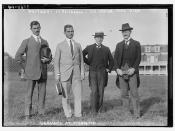John Bugbee
C-063, War and Society
J. Lockenour
12/11/01
Strategic Bombing In WWII
"The new relation of air power to strategy presents one of the distinguishing contrasts between this war and the last. Air power in the last war was in its infancy. The new role of three-dimensional warfare was even then foreseen by a few farsighted men, but planes were insufficient in quality and quantity to permit much more than occasional brilliant assistance to the ground force."
This passage starts off the United States strategic bombing survey. I like this quote because it makes it clear that WWII was a much different war than WWI and begins to explain why. Upon reflection, it simply seems that the U.S. and especially Great Britain were just utilizing the new technology that had become available in mass production. Opposing forces had never seen a weapon as devestating: physically, financially, and agriculturally.
Allied forces didn't even have to use the weapons incredibly well in order for them to have a huge impact on every part of the enemy's resources.
The beginning of the war was marked by mass production of planes. The countries needed these extra planes to carry out the air bombing strategies that they had in place. England possessed about 50% of the air power with the U.S. and Germany splitting the other 50%.
An account of a 1943 British/American raid on Hamburg from the book Voices of the Third Reich is a prime example of strategic bombing's effectiveness in WWII. "The combined bomber offensive struck its first major blow against Hamburg. Operation Gomorrah began on July 24-25, 1943. More than 30,000 people died in a series of raids then unmatched in scope and destruction. For the first time, a German city experienced firestorms: heat from burning buildings so intense...


![[German vehicle tax registration issued to George Grantham Bain] (LOC)](https://s.writework.com/uploads/6/60390/german-vehicle-tax-registration-issued-george-grantham-bain-thumb.jpg)
Good essay
good essay very descriptive
1 out of 2 people found this comment useful.